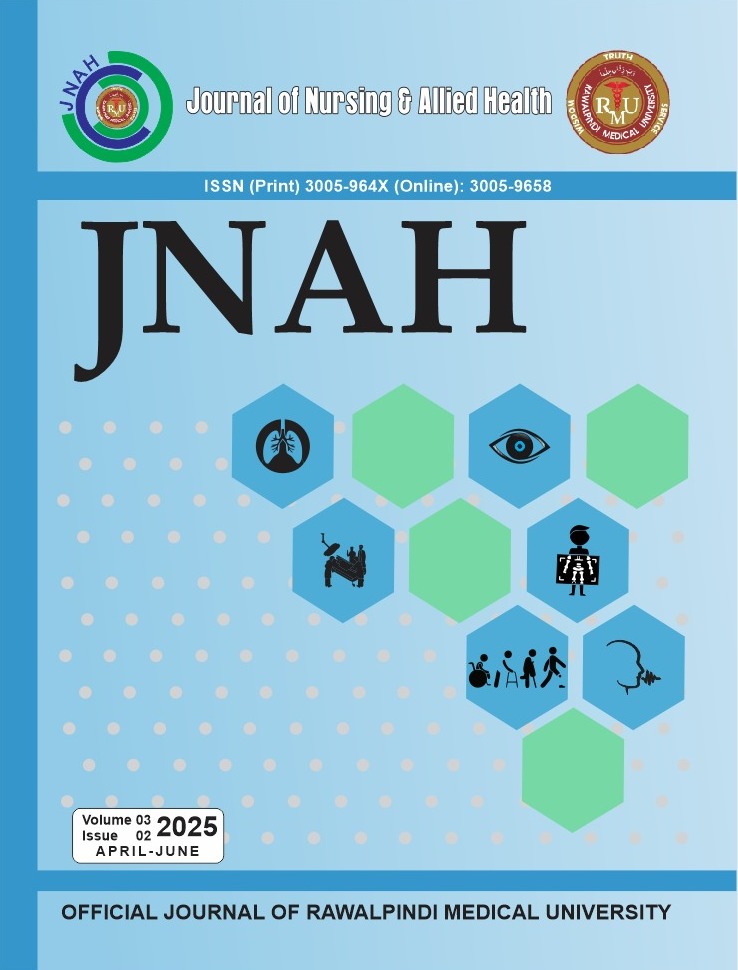Abstract
Objective: The aim was to evaluate the effect of hypertension on renal function by sonographic evaluation of renal cortical thickness and renal parenchymal changes.
Study design: It was an Analytical Cross Sectional study.
Placement and duration of study: The study was conducted at Rashad Hospital Shahkot from September to December 2024.
Material and Methods: The study was started on 100 patients above 30 years of age who had history of hypertension. Purposive sampling technique (non-Random) was done. Renal Ultrasound was performed by using Toshiba NEMIO 200, convex probe 3-5 MHz and all the collected data was analyzed by using SPSS. Renal cortical thickness and renal parenchymal changes were assessed to check their effect on renal function impairment.
Results: 100 patients total in which 59 females and 41 male patients with hypertension were added. The correlation coefficient (R) between the observed and predicted values of the dependent variable (CGeGFR) is 0.375, indicating a moderate positive correlation between the independent variable and the dependent variable. R² = 0.140, which means that approximately 14% of the variance is explained by the independent variable P-value, is 0.000, indicating that the model is statistically significant.
Conclusion: The assessment of Renal Cortical Thickness and changes in Renal Parenchyma through ultrasound may serve as indicators of renal function deterioration in individuals with hypertension. Research indicates that the predictor Mean Cortical Thickness exhibits a significant correlation with the dependent variable CGeGFR. Therefore, incorporating the evaluation of Renal Cortical Thickness and Renal Parenchymal Changes into routine examinations of hypertensive patients could provide important diagnostic and prognostic insights.
Key words: Hypertension, Ultrasound, Renal Cortical Thickness and Renal Parenchymal Changes
References
Kearney PM, Whelton M, Reynolds K, Muntner P, Whelton PK, He J. Global burden of hypertension: analysis of worldwide data. The lancet. 2005;365(9455):217-23.
Mills KT, Stefanescu A, He J. The global epidemiology of hypertension. Nature Reviews Nephrology. 2020;16(4):223-37.
Radermacher J. Ultrasonography of the kidney and the renal vessels: Part I: Normal findings, inherited and renoparenchymatous diseases. INTERNIST. 2003;44(10):1283-+.
El-Reshaid W, Abdul-Fattah H. Sonographic assessment of renal size in healthy adults. Medical principles and practice. 2014;23(5):432-6.
Stämmler F, Grassi M, Meeusen JW, Lieske JC, Dasari S, Dubourg L, et al. Estimating glomerular filtration rate from serum myo-inositol, valine, creatinine and cystatin C. Diagnostics. 2021;11(12):2291.
Rodrigues V, Rodrigues T, Martins A, Dias I, Coutinho A, Palma D. 4CPS-159 Estimating renal function for drug dosing: correlation between ckd-epi and cockcroft-gault in an elderly population. British Medical Journal Publishing Group; 2023.
Widjaja E, Oxtoby J, Hale T, Jones P, Harden P, McCall I. Ultrasound measured renal length versus low dose CT volume in predicting single kidney glomerular filtration rate. The British journal of radiology. 2004;77(921):759-64.
Zanoli L, Romano G, Romano M, Rastelli S, Rapisarda F, Granata A, et al. Renal function and ultrasound imaging in elderly subjects. The Scientific World Journal. 2014;2014(1):830649.
Reddy GM, Reddy SS. Correlation renal cortical echogenicity with serum creatinine in patients with chronic kidney disease. Int J Radiol Diagn Imaging. 2020;3(3):99-102.
Spit KA, Muskiet MH, Tonneijck L, Smits MM, Kramer MH, Joles JA, et al. Renal sinus fat and renal hemodynamics: a cross-sectional analysis. Magnetic Resonance Materials in Physics, Biology and Medicine. 2020;33:73-80.
Musa MJ, Abukonna A. Sonographic measurement of renal size in normal high altitude populations. Journal of radiation research and applied sciences. 2017;10(3):178-82.
Luyckx VA, Brenner BM. The clinical importance of nephron mass. Journal of the American Society of Nephrology. 2010;21(6):898-910.
Adibi A. Renal cortical thickness in adults with normal renal function measured by ultrasonography. Iranian Journal of Radiology. 2008;5(3).
Buchholz N-P, Abbas F, Biyabani SR, Javed Q, Talati JJ, Afzal M, et al. Ultrasonographic renal size in individuals without known renal disease. Journal of the Pakistan Medical Association. 2000;50(1):12.
Kojima S, Shida M, Tanaka K-e, Takano H, Yokoyama H, Kuramochi M. Renal macrostructure and cortical circulation in hypertension assessed by dynamic computed tomography. American journal of hypertension. 2001;14(6):516-23.
Korkmaz M, Aras B, Güneyli S, Yılmaz M. Clinical significance of renal cortical thickness in patients with chronic kidney disease. Ultrasonography, 37 (1), 50-54. 2018.
RS B. Chronic kidney disease in the developing world. New Engl J Med. 2006;354:997-9. World Health Organization. Facts about high blood pressure [Internet].

This work is licensed under a Creative Commons Attribution-ShareAlike 4.0 International License.
Copyright (c) 2025 Journal of Nursing and Allied Health

